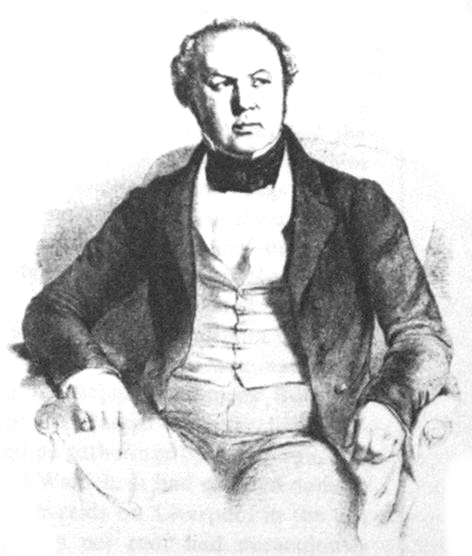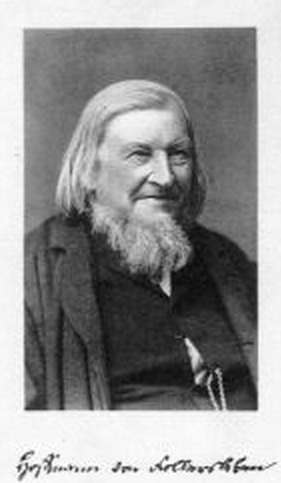|
John Forbes Royle
John Forbes Royle (10 May 1798 – 2 January 1858), British botanist and teacher of materia medica, was born in Kanpur (then Cawnpore) in 1798. He was in charge of the botanical garden at Saharanpur and played a role in the development of economic botany in India. Early life John Forbes Royle was the only son of William Henry Royle and Isabella Forbes. While still a child, his father died and Royle studied under Sangster of Haddington before going to study at Edinburgh high school. He was influenced by Anthony Todd Thomson to take an interest in botany and natural history. This led him to give up a military career at Addiscombe and chose to study medicine. He joined the service of the East India Company as assistant surgeon and went to Calcutta in 1819. He served with the Bengal army (at various times with the 17th and 87th Regiments, Native Artillery, Cavalry and Infantry) at Dum-Dum and in parts of the North-Western Provinces where he found time to study botany and geology, a ... [...More Info...] [...Related Items...] OR: [Wikipedia] [Google] [Baidu] |
Roylea
''Roylea'' is a genus of flowering plant in the family Lamiaceae, first described as a genus in 1830. It contains only one known species, ''Roylea cinerea'', native to the Western Himalayas of Nepal and northern India India, officially the Republic of India ( Hindi: ), is a country in South Asia. It is the seventh-largest country by area, the second-most populous country, and the most populous democracy in the world. Bounded by the Indian Ocean on the .... References Lamiaceae Flora of Nepal Flora of West Himalaya Monotypic Lamiaceae genera Taxa named by David Don Taxa named by Henri Ernest Baillon {{Lamiaceae-stub ... [...More Info...] [...Related Items...] OR: [Wikipedia] [Google] [Baidu] |
1798 Births
Events January–June * January – Eli Whitney contracts with the U.S. federal government for 10,000 muskets, which he produces with interchangeable parts. * January 4 – Constantine Hangerli enters Bucharest, as Prince of Wallachia. * January 22 – A coup d'état is staged in the Netherlands ( Batavian Republic). Unitarian Democrat Pieter Vreede ends the power of the parliament (with a conservative-moderate majority). * February 10 – The Pope is taken captive, and the Papacy is removed from power, by French General Louis-Alexandre Berthier. * February 15 – U.S. Representative Roger Griswold (Fed-CT) beats Congressman Matthew Lyon (Dem-Rep-VT) with a cane after the House declines to censure Lyon earlier spitting in Griswold's face; the House declines to discipline either man.''Harper's Encyclopaedia of United States History from 458 A. D. to 1909'', ed. by Benson John Lossing and, Woodrow Wilson (Harper & Brothers, 1910) p171 * March ... [...More Info...] [...Related Items...] OR: [Wikipedia] [Google] [Baidu] |
People From Saharanpur
A person ( : people) is a being that has certain capacities or attributes such as reason, morality, consciousness or self-consciousness, and being a part of a culturally established form of social relations such as kinship, ownership of property, or legal responsibility. The defining features of personhood and, consequently, what makes a person count as a person, differ widely among cultures and contexts. In addition to the question of personhood, of what makes a being count as a person to begin with, there are further questions about personal identity and self: both about what makes any particular person that particular person instead of another, and about what makes a person at one time the same person as they were or will be at another time despite any intervening changes. The plural form "people" is often used to refer to an entire nation or ethnic group (as in "a people"), and this was the original meaning of the word; it subsequently acquired its use as a plural form of p ... [...More Info...] [...Related Items...] OR: [Wikipedia] [Google] [Baidu] |
Academics Of King's College London
An academy ( Attic Greek: Ἀκαδήμεια; Koine Greek Ἀκαδημία) is an institution of secondary or tertiary higher learning (and generally also research or honorary membership). The name traces back to Plato's school of philosophy, founded approximately 385 BC at Akademia, a sanctuary of Athena, the goddess of wisdom and skill, north of Athens, Greece. Etymology The word comes from the ''Academy'' in ancient Greece, which derives from the Athenian hero, ''Akademos''. Outside the city walls of Athens, the gymnasium was made famous by Plato as a center of learning. The sacred space, dedicated to the goddess of wisdom, Athena, had formerly been an olive grove, hence the expression "the groves of Academe". In these gardens, the philosopher Plato conversed with followers. Plato developed his sessions into a method of teaching philosophy and in 387 BC, established what is known today as the Old Academy. By extension, ''academia'' has come to mean the accumulation, ... [...More Info...] [...Related Items...] OR: [Wikipedia] [Google] [Baidu] |
Fellows Of The Royal Society
Fellowship of the Royal Society (FRS, ForMemRS and HonFRS) is an award granted by the judges of the Royal Society of London to individuals who have made a "substantial contribution to the improvement of natural knowledge, including mathematics, engineering science, and medical science". Fellowship of the Society, the oldest known scientific academy in continuous existence, is a significant honour. It has been awarded to many eminent scientists throughout history, including Isaac Newton (1672), Michael Faraday (1824), Charles Darwin (1839), Ernest Rutherford (1903), Srinivasa Ramanujan (1918), Albert Einstein (1921), Paul Dirac (1930), Winston Churchill (1941), Subrahmanyan Chandrasekhar (1944), Dorothy Hodgkin (1947), Alan Turing (1951), Lise Meitner (1955) and Francis Crick (1959). More recently, fellowship has been awarded to Stephen Hawking (1974), David Attenborough (1983), Tim Hunt (1991), Elizabeth Blackburn (1992), Tim Berners-Lee (2001), Venki Ramakris ... [...More Info...] [...Related Items...] OR: [Wikipedia] [Google] [Baidu] |
English Botanists
English usually refers to: * English language * English people English may also refer to: Peoples, culture, and language * ''English'', an adjective for something of, from, or related to England ** English national identity, an identity and common culture ** English language in England, a variant of the English language spoken in England * English languages (other) * English studies, the study of English language and literature * ''English'', an Amish term for non-Amish, regardless of ethnicity Individuals * English (surname), a list of notable people with the surname ''English'' * People with the given name ** English McConnell (1882–1928), Irish footballer ** English Fisher (1928–2011), American boxing coach ** English Gardner (b. 1992), American track and field sprinter Places United States * English, Indiana, a town * English, Kentucky, an unincorporated community * English, Brazoria County, Texas, an unincorporated community ... [...More Info...] [...Related Items...] OR: [Wikipedia] [Google] [Baidu] |
Botanists With Author Abbreviations
This is a list of botanists who have Wikipedia articles, in alphabetical order by surname. The List of botanists by author abbreviation is mostly a list of plant taxonomists because an author receives a standard abbreviation only when that author originates a new plant name. Botany is one of the few sciences which can boast, since the Middle Ages, of a substantial participation by women. A * Erik Acharius * Julián Acuña Galé *Johann Friedrich Adam * Carl Adolph Agardh * Jacob Georg Agardh * Nikolaus Ager * William Aiton * Frédéric-Louis Allamand *Carlo Allioni * Prospero Alpini * Benjamin Alvord * Adeline Ames * Eliza Frances Andrews * Agnes Arber * Giovanni Arcangeli *David Ashton * William Guybon Atherstone * Anna Atkins *Daniel E. Atha *Armen Takhtajan B * Ernest Brown Babcock * Churchill Babington * Curt Backeberg * James Eustace Bagnall * Jacob Whitman Bailey *Liberty Hyde Bailey * Ibn al-Baitar * Giovanni Battista Balbis * John Hutton Balfour *Joseph Bank ... [...More Info...] [...Related Items...] OR: [Wikipedia] [Google] [Baidu] |
Royal Botanic Gardens, Kew
Royal Botanic Gardens, Kew is a non-departmental public body in the United Kingdom sponsored by the Department for Environment, Food and Rural Affairs. An internationally important botanical research and education institution, it employs 1,100 staff. Its board of trustees is chaired by Dame Amelia Fawcett. The organisation manages botanic gardens at Kew in Richmond upon Thames in south-west London, and at Wakehurst, a National Trust property in Sussex which is home to the internationally important Millennium Seed Bank, whose scientists work with partner organisations in more than 95 countries. Kew, jointly with the Forestry Commission, founded Bedgebury National Pinetum in Kent in 1923, specialising in growing conifers. In 1994, the Castle Howard Arboretum Trust, which runs the Yorkshire Arboretum, was formed as a partnership between Kew and the Castle Howard Estate. In 2019, the organisation had 2,316,699 public visitors at Kew, and 312,813 at Wakehurst. Its site ... [...More Info...] [...Related Items...] OR: [Wikipedia] [Google] [Baidu] |
Charles Holtzapffel
Charles Holtzapffel was a mechanical engineer and technical writer and one of the Holtzapffel dynasty of tool and lathe makers. He wrote a five volume treatise called ''Turning and Mechanical Manipulation'''','' which is considered a blueprint for ornamental turning, with over 3000 pages and 1600 illustrations''''. Charles was the son of John Jacob Holtzapffel, originally from Alsace who set up a tool-making partnership in Long Acre with Franic Rousset in 1793. Charles was educated in England. Business Charles joined his father's firm, Holtzapfell & Co. in 1827. The firm was based at 64, Charing Cross Road, with manufacturing at 127 Long Acre. After his father died in 1835, Charles continued to run the business. He also invented machinery for printing banknotes, lathes for cutting rosettes, and equipment for tracing shapes on glass and introduced a new system of measures based on the decimal sub-division of the standard inch, as a replacement for the method of measurin ... [...More Info...] [...Related Items...] OR: [Wikipedia] [Google] [Baidu] |
Royle's Pika
Royle's pika (''Ochotona roylei''), also called the Himalayan mouse hare or hui shutu, is a species of pika. It is found in Bhutan, China, India, Nepal, and Pakistan. Description The most common pika species in the Himalayas, it has a length of 17-22 centimeters. Royle's pika has a slightly arched head, with a rufous-grey body and chestnut-colored head, as well as sparse hair in front of its ears. Distribution and habitat This is the most common pika species in the Himalayas, and can be confused with the sympatric large-eared pika. These species are mostly seen in the open rocky mountain edges or slopes, or on ground covered with conifer trees, such as pine, deodar and rhododendron forests. Royle's pika are a crepuscular foraging species, as they tend to be inactive during midday hours. Reduction of activity during the midday is also contributed to increasing temperatures, which causes heat stress on the species.Bhattacharyya, S., Adhikari, B. S., & Rawat, G. S. (2014). "Infl ... [...More Info...] [...Related Items...] OR: [Wikipedia] [Google] [Baidu] |


_1938.jpg)


